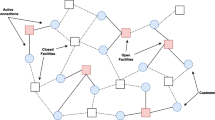Abstract
The Maximal Covering Location Problem (MCLP) maximizes the population that has a facility within a maximum travel distance or time. Numerous extensions have been proposed to enhance its applicability, like the probabilistic model for the maximum covering location-allocation with constraint in waiting time or queue length for congested systems, with one or more servers per service center. This paper presents one solution procedure for that probabilistic model, considering one server per center, using a Hybrid Heuristic known as Clustering Search (CS), that consists of detecting promising search areas based on clustering. The computational tests provide results for network instances with up to 818 vertices.
Similar content being viewed by others
References
Brotcorne L., Laporte G. and Semet F. (2003). Ambulance Location and relocation models. European Journal of Operational Research, 147, pp. 451–463.
Chaves A. A. and Lorena L. A. N. (2005). Hybrid algorithms with detection of promising areas for the prize collecting traveling salesman problem. Fifth international conference on hybrid intelligent systems (HIS’05), pp. 49–54.
Chung C.H. (1986). Recent applications of the Maximal Covering Location Problem (MCLP) model. Journal of the Operational Research Society. 37, pp. 735–746.
Church R.L. and ReVelle C. (1974). Maximal covering location problem. Papers of the Regional Science Association, 32, pp. 101–118.
Corrêa F.A. and Lorena L.A.N. (2006). Using the Constructive Genetic Algorithm for Solving the Probabilistic Maximal Covering Location-Allocation Problem. I Workshop on Computational Intelligence/SBRN. Available at http://www.lac.inpe.br/~lorena/correa/Correa_Lorena_Wci_2006.pdf.
Current J. R. and O’Kelly M. (1981). Locating emergency warning sirens. Decision Sciences, 23, pp. 221–234.
Daskin M. S. (1995). Network and discrete location: models, algorithms and applications. John Wiley & Sons, New York.
Eaton D., Hector M., Sanchez V., Latingua R. and Morgan J. (1986). Determining ambulance deployment in Santo Domingo, Dominican Republic. Journal of the Operational Research Society, 37, pp. 113–126.
Feo T. and Resende M. (1995). Greedy randomized adaptive search procedures. Journal of Global Optimization, 6, pp. 109–133.
Galvão R.D. (2004). Uncapacitated facility location problems: contributions. Pesquisa Operacional, 24: 7–38.
Galvão R. D. and ReVelle C. S. (1996). A Lagrangean heuristic for the maximal covering location problem. European Journal of Operational Research, 88, pp. 114–123.
Glover F. (1996). Tabu search and adaptive memory programming: Advances, applications and challenges. Interfaces in Computer Science and Operations Research, pp. 1–75.
Hale T. S. and Moberg C. R. (2003). Location science review. Annals of Operations Research, 123, pp. 21–35.
Hougland E. S. and Stephens N. T. (1976). Air pollulant monitor sitting by analytical techniques. Journal of the Air Pollution Control Association, 26, pp. 52–53.
ILOG CPLEX 10.0: User’s Manual, France, 2006.
Larson R. C. and Odoni A. R. (1981). Urban operations research, Prentice Hall, Englewood Cliffs, N.J.
Lorena L. A. N. and Furtado J. C. (2001). Constructive genetic algorithm for clustering problems. 〈http://www.lac.inpe.br/%7Elorena/cga/cga_clus.PDF〉 Evolutionary Computation 〈http://mitpress.mit.edu/journal-home.tcl?issn=10636560〉, 9(3), pp. 309–327.
Lorena L. A. N. and Pereira M. A. (2002). A lagrangean/surrogate heuristic for the maximal covering location problem using Hillsman’s edition, International Journal of Industrial Engineering, 9, pp. 57–67.
Marianov V. and Serra D. (1998). Probabilistic maximal covering location-allocation models for congested systems. Journal of Regional Science, 38(3): 401–424.
Marianov V. and Serra D. (2001). Hierarchical location-allocation models for congested systems. European Journal of Operational Research, 135: 195–208.
Moore G. C. and ReVelle C.S. (1982). The Hierarchical Service Location Problem, Management Science, 28 (7), pp. 775–780.
Oliveira A. C. M. and Lorena L. A. N. (2004). Detecting-promising areas by evolutionary clustering search. Bazzan, A. L. C. and Labidi, S. (Eds.) Springer Lecture Notes in Artificial Intelligence Series vol. 3171, pp. 385–394.
Oliveira A. C. M. and Lorena L. A. N. (2005). Population training heuristics 〈http://www.lac.inpe.br/%7Elorena/alexandre/Evo2005tph.pdf〉. Gottlieb, J. and Raidl, G. (Eds.) Springer Lecture Notes in Computer Science Series Vol. 3448, pp. 166–176.
Oliveira A. C. M. and Lorena L. A. N. (2007). Hybrid Evolutionary Algorithms and Clustering Search. Crina Grosan, Ajith Abraham and Hisao Ishibuchi (Eds.) Springer SCI Series, vol. 75, pp. 81–102.
Pereira M. A., Lorena L. A. N. and Senne E. L. F. (2007). A column generation approach for the maximal covering location problem. International Transactions in Operations Research, v. 14, p. 349–364.
Pirkul H. and Schilling D. A. (1991). The maximal covering location problem with capacities on total workload. Management Science, 37(2), pp. 233–248.
Serra D. and Marianov V. (2004). New trends in public facility location modeling. Universitat Pompeu Fabra Economics and Business Working Paper 755. Available at 〈http://www.econ.upf.edu/docs/papers/downloads/755.pdf〉.
Author information
Authors and Affiliations
Rights and permissions
About this article
Cite this article
de Assis Corrêa, F., Chaves, A.A. & Lorena, L.A.N. Hybrid heuristics for the probabilistic maximal covering location-allocation problem. Oper Res Int J 7, 323–343 (2007). https://doi.org/10.1007/BF03024852
Issue Date:
DOI: https://doi.org/10.1007/BF03024852




